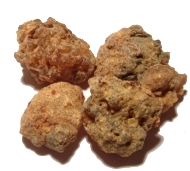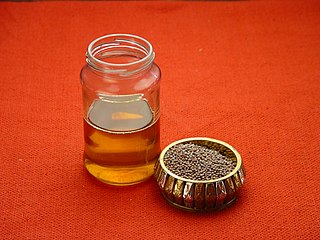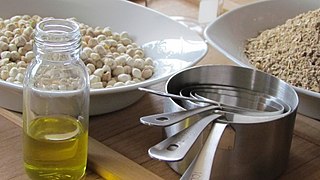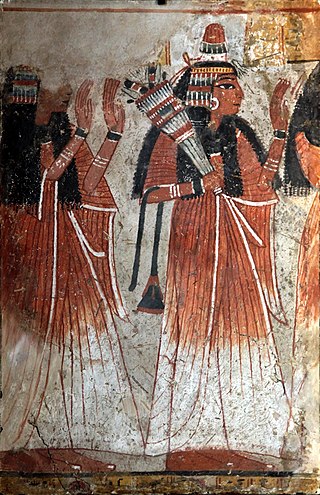Related Research Articles

Seasoning is the process of supplementing food via herbs, spices, salts, and/or sugar, intended to enhance a particular flavour.

Soap is a salt of a fatty acid used in a variety of cleansing and lubricating products. In a domestic setting, soaps are surfactants usually used for washing, bathing, and other types of housekeeping. In industrial settings, soaps are used as thickeners, components of some lubricants, and precursors to catalysts.

In polymer chemistry and materials science, a resin is a solid or highly viscous substance of plant or synthetic origin that is typically convertible into polymers. Resins are usually mixtures of organic compounds. This article focuses mainly on naturally occurring resins.

Myrrh is a gum-resin extracted from a few small, thorny tree species of the Commiphora genus, belonging to the Burseraceae family. Myrrh resin has been used throughout history in medicine, perfumery, and incenses. Myrrh mixed with posca or wine was widely used in many ancient cultures to produce pleasurable feelings and as an anti-inflammatory and analgesic.
Perfume is a mixture of fragrant essential oils or aroma compounds (fragrances), fixatives and solvents, usually in liquid form, used to give the human body, animals, food, objects, and living-spaces an agreeable scent. Perfumes can be defined as substances that emit and diffuse a pleasant and fragrant odor. They consist of manmade mixtures of aromatic chemicals and essential oils. The 1939 Nobel Laureate for Chemistry, Leopold Ružička stated in 1945 that "right from the earliest days of scientific chemistry up to the present time, perfumes have substantially contributed to the development of organic chemistry as regards methods, systematic classification, and theory."

Coriander, also known as cilantro and dhaniya, is an annual herb in the family Apiaceae. All parts of the plant are edible, but the fresh leaves and the dried seeds are the parts most traditionally used in cooking.

Mustard oil can mean either the pressed oil used for cooking, or a pungent essential oil also known as volatile oil of mustard. The essential oil results from grinding mustard seed, mixing the grounds with water, and isolating the resulting volatile oil by distillation. It can also be produced by dry distillation of the seed. Pressed mustard oil is used as cooking oil in some cultures, but sale is restricted in some countries due to high levels of erucic acid. Varieties of mustard seed also exist that are low in erucic acid.

Onycha, along with equal parts of stacte, galbanum, and frankincense, was one of the components of the consecrated Ketoret (incense) which appears in the Torah book of Exodus (Ex.30:34-36) and was used in Solomon's Temple in Jerusalem. This formula was to be incorporated as an incense, and was not to be duplicated for non-sacred use. What the onycha of antiquity actually was cannot be determined with certainty. The original Hebrew word used for this component of the ketoret was שחלת, shecheleth, which means "to roar; as a lion " or “peeling off by concussion of sound." Shecheleth is related to the Syriac shehelta which is translated as “a tear, distillation, or exudation.” In Aramaic, the root SHCHL signifies “retrieve.” When the Torah was translated into Greek the Greek word “onycha” ονυξ, which means "fingernail" or "claw," was substituted for shecheleth.

Agarwood, aloeswood, eaglewood, gharuwood or the Wood of Gods, most commonly referred to as oud or oudh, is a fragrant, dark and resinous wood used in incense, perfume, and small hand carvings. It forms in the heartwood of Aquilaria trees after they become infected with a type of Phaeoacremonium mold, P. parasitica. The tree defensively secretes a resin to combat the fungal infestation. Prior to becoming infected, the heartwood mostly lacks scent, and is relatively light and pale in colouration. However, as the infection advances and the tree produces its fragrant resin as a final option of defense, the heartwood becomes very dense, dark, and saturated with resin. This product is harvested, and most famously referred to in cosmetics under the scent names of oud, oodh or aguru; however, it is also called aloes, agar, as well as gaharu or jinko. With thousands of years of known use, and valued across Muslim, Christian, and Hindu communities, oud is prized in Middle Eastern and South Asian cultures for its distinctive fragrance, utilized in colognes, incense and perfumes.
The holy anointing oil formed an integral part of the ordination of the priesthood and the High Priest as well as in the consecration of the articles of the Tabernacle and subsequent temples in Jerusalem. The primary purpose of anointing with the holy anointing oil was to sanctify, to set the anointed person or object apart as qodesh, or "holy".
A fixative is a substance used to equalize the vapor pressures, and thus the volatilities, of the raw materials in a perfume oil, and to increase the perfume's odour tenacity.

Balm of Gilead was a rare perfume used medicinally that was mentioned in the Hebrew Bible and named for the region of Gilead, where it was produced. The expression stems from William Tyndale's language in the King James Bible of 1611 and has come to signify a universal cure in figurative speech. The tree or shrub producing the balm is commonly identified as Commiphora gileadensis. However, some botanical scholars have concluded that the actual source was a terebinth tree in the genus Pistacia.

Ben oil is pressed from the seeds of the Moringa oleifera, known variously as the horseradish tree, ben oil tree, or drumstick tree. The oil is characterized by an unusually long shelf life and a mild, but pleasant taste. The name of the oil is derived from the presence of behenic acid. The oil's components are:

Fragrance extraction refers to the separation process of aromatic compounds from raw materials, using methods such as distillation, solvent extraction, expression, sieving, or enfleurage. The results of the extracts are either essential oils, absolutes, concretes, or butters, depending on the amount of waxes in the extracted product.

Stacte and nataph are names used for one component of the Solomon's Temple incense, the Ketoret, specified in the Book of Exodus. Variously translated to the Greek term or to an unspecified "gum resin" or similar, it was to be mixed in equal parts with onycha, galbanum and mixed with pure frankincense and they were to "beat some of it very small" for burning on the altar of the tabernacle.
Cosmetics, first used in ancient Rome for ritual purposes, were part of daily life. Some fashionable cosmetics, such as those imported from Germany, Gaul and China, were so expensive that the Lex Oppia tried to limit their use in 189 BCE. These "designer brands" spawned cheap knock-offs that were sold to poorer women. Working-class women could afford the cheaper varieties, but may not have had the time to apply the makeup as the use of makeup was a time-consuming affair because cosmetics needed to be reapplied several times a day due to weather conditions and poor composition.

Cumin is a flowering plant in the family Apiaceae, native to the Irano-Turanian Region. Its seeds – each one contained within a fruit, which is dried – are used in the cuisines of many cultures in both whole and ground form. Although cumin is used in traditional medicine, there is no high-quality evidence that it is safe or effective as a therapeutic agent.

The history of spices reach back thousands of years, dating back to the 8th century B.C. Spices are widely known to be developed and discovered in Asian civilizations. Spices have been used in a variety of antique developments for their unique qualities. There were a variety of spices that were used for common purposes across the ancient world. Different spices hold a value that can create a variety of products designed to enhance or suppress certain taste and/or sensations. Spices were also associated with certain rituals to perpetuate a superstition or fulfill a religious obligation, among other things.

Head cones, also known as perfume cones or wax cones were a type of conical ornament worn atop the head in ancient Egypt. They are often depicted on paintings and bas-reliefs of the era, but were not found as archaeological evidence until 2009, according to research published in 2019.